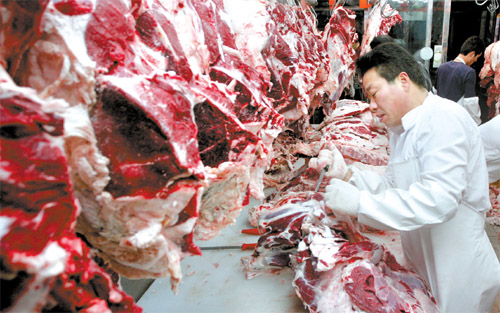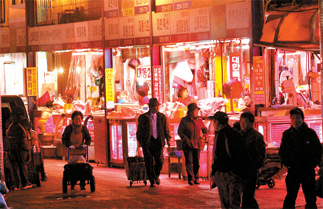Meat market is not for fainthearted

A butcher at a meat shop at Majang Meat Market skillfully chops beef. By Oh Sang-min
Refrigerator trucks hurry down a narrow two-way street, sometimes creating congestion that takes the better part of an hour to clear.
They park by small meat stores on both sides of the street. Quickly, slabs of beef are handed over to workers rushing out from the stores. Back inside, the slabs are worked over with sharp knives. In the blink of an eye, they are chiseled into ribs, sirloin, short loin, shank and brisket.
The clock says it’s only 7:50 a.m., but according to meat sellers, the Majang Meat Market is already past its peak daily rush. “The opening time here is 5 a.m. That’s when this market is the busiest,” said a merchant.
The Majang Meat Market, the biggest wholesale and retail meat market in Korea, distributes fresh beef and pork to Seoul and the surrounding area.
The Seongdong District Office, the northeastern Seoul office that governs the outdoor meat market, estimates that the market provides up to 70 percent of all meat consumed in the metropolitan area.
Some say it is the biggest beef and pork market in Asia, though there is no official way to prove it.
Built on 116,150 square meters (28 acres) in Majang-dong, the market receives around 2.5 million customers annually, according to the district office. Many are consumers but others are retailers, including those from hotels, large discount stores and neighborhood butcher shops. Annual meat sales tally 150 billion won ($115.1 million).
Around 12,000 people work for some 3,000 meat shops at the market.
The market was originally located in Sungin-dong in Jongno District, central Seoul, before moving in 1963 to the current location. It was initially called the Majang Beef Market, as its main trade is beef. The name was changed to Majang Meat Market a few years ago.

Customers and meat merchants make their way along an entrance of Majang Meat Market in Majang-dong, Seoul. By Oh Sang-min
Until a decade ago, it was an even more gruesome sight.
The market had slaughterhouses where up to 250 cows and 2,000 pigs were killed daily. In 1998, the slaughterhouses moved to Doksan-dong,
Refrigerator trucks hurry down a narrow two-way street, sometimes creating congestion that takes the better part of an hour to clear.
They park by small meat stores on both sides of the street. Quickly, slabs of beef are handed over to workers rushing out from the stores. Back inside, the slabs are worked over with sharp knives. In the blink of an eye, they are chiseled into ribs, sirloin, short loin, shank and brisket.
The clock says it’s only 7:50 a.m., but according to meat sellers, the Majang Meat Market is already past its peak daily rush. “The opening time here is 5 a.m. That’s when this market is the busiest,” said a merchant.
The Majang Meat Market, the biggest wholesale and retail meat market in Korea, distributes fresh beef and pork to Seoul and the surrounding area.
The Seongdong District Office, the northeastern Seoul office that governs the outdoor meat market, estimates that the market provides up to 70 percent of all meat consumed in the metropolitan area.
Some say it is the biggest beef and pork market in Asia, though there is no official way to prove it.
Built on 116,150 square meters (28 acres) in Majang-dong, the market receives around 2.5 million customers annually, according to the district office. Many are consumers but others are retailers, including those from hotels, large discount stores and neighborhood butcher shops. Annual meat sales tally 150 billion won ($115.1 million).

The market was originally located in Sungin-dong in Jongno District, central Seoul, before moving in 1963 to the current location. It was initially called the Majang Beef Market, as its main trade is beef. The name was changed to Majang Meat Market a few years ago.
As any other meat market, the Majang Market is not a place for the fainthearted. Cow and pig heads dangle on poles, internal organs sit in blood-soaked washbowls, and a smell most foul penetrates the air. A newcomer could well feel a chill walking past the red-lit meat shops.
Until a decade ago, it was an even more gruesome sight.
The market had slaughterhouses where up to 250 cows and 2,000 pigs were killed daily. In 1998, the slaughterhouses moved to Doksan-dong, southwestern Seoul, due in part to mounting complaints from residents that cries from dying animals disturbed them.
Meat sold in the Majang Market is provided by slaughterhouses at Garak Market, an agricultural goods market in southeastern Seoul. Around 1,000 cows are slaughtered in Garak Market a day and 70 percent of their meat goes to the Majang Market.
Meat from thousands of pigs that are sold at Majang a day are also delivered from Garak.
When beef is delivered from Garak, it comes in four parts. To an outsider it seems a daunting task to butcher the animals.
But butchers there don’t agree.
An employee of a meat shop, declining to be named, said he has worked at the market for the past eight years.
“It is not that hard to do this,” he said, while skillfully chopping away a hind leg of a cow. He said his shop butchers six cows a day.
“If you work long here, you will realize that this requires good technique. And it’s very rewarding when you get all the chopping done,” he added.
If that is the case, butchers specialized in beef may feel more rewarded than pork professionals. Butchers said slicing beef requires a more refined technique than slicing pork.
“Those who can slice beef can slice pig at ease, but those who slice pork have difficulty slicing beef,” said another butcher, also without giving his name. “It’s like those that drive manual transmission cars can easily drive cars with automatic transmissions, but not vice versa.”
The quality of beef at the market is put in one of four classifications depending on the amount of intramuscular fat. The meat with highest intramuscular fat is ranked A, with meat rated B, C and D following.
According to the association of meat sellers at Majang, the prices of the meat traded at the market are 20 to 30 percent lower than those at large-sized discount stores.
“For the cheapest prices, you can also buy a lot of offal from the animals here that you cannot find at discount stores,” said Go Ki-bok, an executive director of the Ma Jang Meat Market Merchant Association.
The merchant association has tried to make the market more appealing.
In October 2002, it erected a steel plate roof over the street. It also created a food court section where several restaurants serve meat provided by shops within the market. Still, the market has a long way to go. There are 367 buildings at the market, about half of which appear aged.
“We plan to start a modernization project soon to make it a meat market appealing to more people from home and abroad,” said Lee Yong-ae, an official of Seongdong District Office.
Some are concerned, however, that the ongoing economic distress could foil the market’s plan. “We don’t have as many customers these days,” Go from the association said.
Go said the upcoming Lunar New Year is expected to serve as a boost.
“The holiday is coming up and the market has regained a bit of its dynamism. We hope this could turn the tide for us struggling in the economic crisis,” he said.
By Moon Gwang-lip Staff Reporter [joe@joongang.co.kr]










with the Korea JoongAng Daily
To write comments, please log in to one of the accounts.
Standards Board Policy (0/250자)